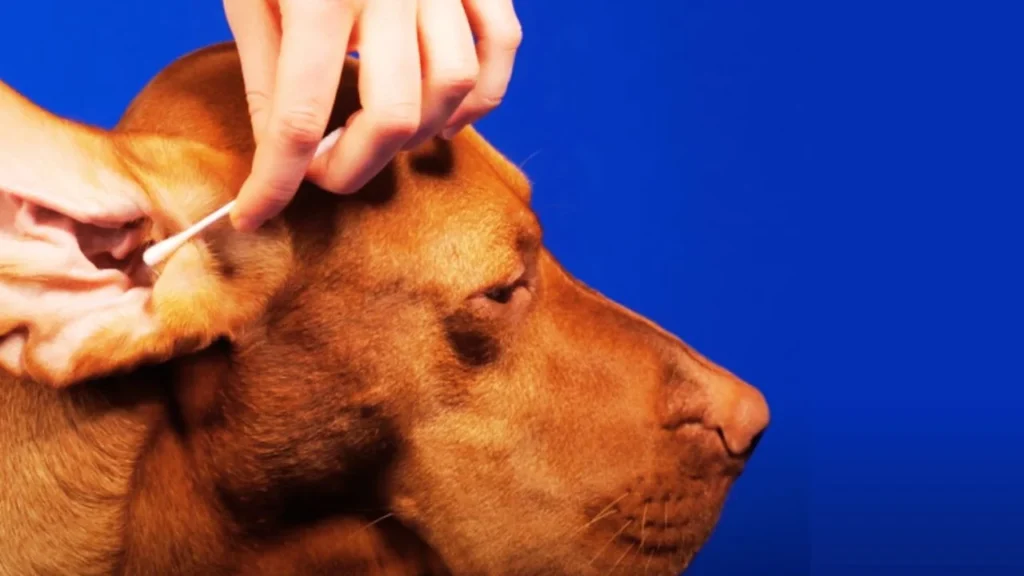When it comes to dog ear mites vs ear wax, it’s crucial to understand the difference for proper treatment. Ear mites are responsible for about 50% of ear infections in dogs, causing discomfort and irritation. On the other hand, ear wax buildup can also lead to problems if not managed properly.
In fact, excessive ear wax is a common cause of vet visits, affecting 20% of dogs. Certain breeds are more susceptible to it, so it’s essential to monitor their ears closely. Using a dog shampoo for dry, itchy skin can also help soothe irritation and support overall skin health.
Are certain dog breeds more prone to ear mites or ear wax buildup?

Yes, certain dog breeds are more prone to Dog Ear Mites vs Ear Wax issues. Dogs with floppy ears, such as Cocker Spaniels, Basset Hounds, and Bloodhounds, are more susceptible to ear problems due to reduced air circulation in the ear canal.
This can lead to a higher risk of both ear wax buildup and ear infections. Additionally, dogs with allergies or those that spend a lot of time outdoors may also be more prone to ear mites. Regular ear cleaning and veterinary check-ups are essential for these breeds to prevent infections and maintain ear health.
Comparison Table
Ear Mites in Dogs

Ear mites can be one of the most frustrating things to deal with when it comes to your dog’s health. As a pet owner, I’ve found that knowing the signs and symptoms early can help in providing the right treatment. These microscopic pests are small but can cause significant discomfort for your dog.
What Are Ear Mites?
Ear mites, scientifically known as Otodectes cynotis, are tiny parasites that live in the ear canal of animals. These mites thrive by feeding on the skin debris inside your dog’s ear, which can lead to infection and irritation. They’re about 0.1 to 0.2 millimeters in size, so they’re almost invisible to the naked eye, making them difficult to spot unless you know the signs.
How Do Ear Mites Spread?
I’ve learned that ear mites are highly contagious, especially among animals that live in the same household or are frequently in contact with each other. These parasites can jump from one pet to another through direct contact. Whether your dog spends time at the dog park or with other animals, it’s important to be aware that ear mites can spread rapidly in such environments.
Symptoms of Ear Mites
When my dog was first affected by ear mites, I noticed several signs that made me suspect something was wrong. The most noticeable symptom was the intense scratching and shaking of the head. You might also see a dark, crumbly discharge in the ear, which resembles coffee grounds. If you notice these symptoms, it’s important to act quickly, as they can cause inflammation and pain.
Diagnosing Ear Mites
If you’re noticing these signs, it’s always best to consult a vet for a proper diagnosis. The vet will use an otoscope to examine your dog’s ear canal, and they might also take a sample of the ear discharge to check under a microscope for the presence of ear mites. It’s crucial not to delay seeking help, as untreated ear mites can lead to serious ear infections or even hearing loss in severe cases.
Treatment Options
I learned that ear mites are treatable, and there are several options available to get rid of them. Most commonly, vets will prescribe ear drops or topical treatments that kill the mites directly. Depending on the severity, the treatment might take from one to three weeks to fully resolve the issue. Regular ear cleaning is also essential to remove debris and soothe any irritation caused by the mites.
Ear Wax in Dogs

Ear wax, also known as cerumen, plays a crucial role in your dog’s ear health. It’s a natural secretion that helps protect the ear canal from dust, debris, and even bacteria. But when things go awry, it can lead to discomfort or even infection, so let’s dive into how it works and when it becomes a problem.
What Is Ear Wax and Why Is It Important?
Ear wax is produced by specialised glands in your dog’s ear canal. It’s a mix of secretions from glands and dead skin cells that work together to trap dirt and keep the ear clean. Think of it as your dog’s built-in defence system until there’s too much of it!
Normal Ear Wax
Normal ear wax is essential for maintaining your dog’s ear health. It’s a natural and protective secretion produced by the ear glands. When the ear wax is in the right amount, it helps lubricate the ear canal and traps dust, dirt, and other debris that could cause irritation or infection. Think of it as the ear’s self-cleaning mechanism, working silently in the background.
For most dogs, normal ear wax is light yellow to brown in color and has a soft, sticky texture. It’s typically produced in small amounts that shouldn’t be problematic. The key here is that it’s not excessive or blocking the ear canal, which would lead to discomfort or potential health issues.
Symptoms of Normal Ear Wax
Normal ear wax doesn’t cause any obvious symptoms. In fact, you probably won’t notice it unless you’re inspecting your dog’s ears. However, there are a few characteristics to keep in mind that indicate the ear wax is in its healthy, natural state:
- Light yellow to brown colour
- Small, soft amountsare visible in the ear canal
- No foul odour or irritation around the ear
When everything is functioning as it should, your dog’s ear wax will be just enough to keep the ear clean without causing any issues. Regular check-ups should be enough to ensure that it remains in this healthy, balanced state.
Managing Normal Ear Wax
In general, no special treatment is required for normal ear wax. Routine checks during grooming sessions or vet visits can help ensure that the ear wax isn’t becoming excessive. If you notice a small amount of wax during a regular check-up, there’s no need to worry. Just ensure your dog’s ears are kept clean, and avoid inserting anything deep into the ear canal. Regular cleaning with a vet-approved ear cleaner once a week should suffice to keep everything in balance.
Excessive Ear Wax
However, excessive ear wax can cause problems. If you start noticing a thicker, darker, or larger amount of wax, it could indicate an underlying issue. Dog Ear Mites vs Ear Wax can be confusing, but excessive wax buildup may cause discomfort or even a higher risk of infections, which may require a vet’s attention.
Symptoms of Excessive Ear Wax
Excessive ear wax can cause several signs of discomfort for your dog. If you notice any of the following, it might be time to check your dog’s ears:
- Increased head shaking
- Constant ear scratching or rubbing
- Foul odour coming from the ears
- Visible wax buildup or dark discharge
- Redness or swelling in the ear canal
- Tilting the head or difficulty hearing
These symptoms are often indicators that your dog is experiencing discomfort due to excessive ear wax, and they may need some attention or professional care.
How to Manage Excessive Ear Wax
So, what do you do if you find yourself dealing with too much ear wax? Regular cleaning is key. It’s recommended to clean your dog’s ears about once a week to maintain a healthy balance. You can use a veterinarian-approved ear cleaner to gently remove the buildup. And always be careful—using cotton swabs in the ear canal can be risky!
Key Differences| Dog Ear Mites vs Ear Wax
In this section, we’ll break down the key differences between ear mites and ear wax so you can easily tell them apart. It’s important to understand these differences to ensure the right treatment for your dog’s ear health.
Appearance
One of the first things you’ll notice when looking at your dog’s ears is the discharge. Ear mites often produce a dark, crumbly discharge that looks like coffee grounds, whereas ear wax is typically soft, sticky, and light yellow to brown. If you’re seeing something that looks like dirt or ground coffee in the ears, chances are it’s ear mites. A thick, yellowish wax buildup is more likely just excessive ear wax.
Symptoms
Ear mites come with more obvious signs, like intense itching and constant head shaking. Dogs with ear mites often scratch their ears excessively, sometimes leading to redness and swelling of the ear canal. On the other hand, if your dog has too much ear wax, you might notice mild discomfort, occasional scratching, or even a slight odour. It’s important to remember that ear mites cause way more irritation than earwax.
Transmission
A big difference between the two is that ear mites are highly contagious. They can spread easily from one animal to another, especially in multi-pet households or places where animals interact frequently. Ear wax, however, is not contagious at all. It’s just a part of your dog’s ear maintenance, and it’s linked to their health rather than any contagious issue.
Treatment
Treating ear mites is a bit more involved, as you’ll need to use specific medications to eliminate the parasites. Usually, a vet will recommend topical treatments or ear drops to get rid of them. In contrast, excessive earwax can be managed with regular cleaning and ear care products. If your dog’s earwax is the issue, there’s no need for heavy medication, just good hygiene!
Prevention and Maintenance
Maintaining your dog’s ear health is not just about cleaning; it’s about preventing issues from arising in the first place. Regular ear inspections and proper care routines can go a long way in keeping ear mites and wax buildup at bay. Using an antifungal shampoo for dogs can also help protect against infections that may contribute to ear discomfort.
Regular Ear Inspections
I recommend inspecting your dog’s ears at least once a week. During this check, look for any redness, swelling, or unusual discharge. For example, you might notice if your dog has a wax buildup of more than 10% of the ear canal space, which could be a sign of something amiss.
Proper Ear Cleaning
Keeping your dog’s ears clean is essential, but you don’t need to do it daily. I usually clean my dog’s ears every 2-3 weeks using a vet-approved ear solution. Over-cleaning can irritate the ear canal, so it’s essential to find that perfect balance.
Environmental Management
Creating a clean environment can help prevent ear mites, which spread quickly. Keeping bedding, toys, and floors clean can reduce the risk of an infestation. For instance, washing your dog’s bedding weekly can cut down on allergens and mites by 30%, which makes a noticeable difference in ear health.
Veterinary Check-ups
Routine vet check-ups are a must. I schedule regular visits for my dog every 6-12 months, but if you notice issues like persistent scratching or foul odor, it’s time to go sooner. A quick visit can prevent bigger issues, saving you money and stress in the long run.
When to Seek Veterinary Care
If your dog’s ear condition doesn’t improve with home care, it might be time to see a vet. Addressing the issue early can prevent more serious complications. Using a medicated dog shampoo for skin allergies can also help manage skin-related issues that contribute to discomfort.
Constant Itching or Scratching
If your dog is constantly itching or scratching at its ears, it’s a sign that something might be wrong. For example, if you notice your dog scratching more than 5-6 times an hour, it’s a good idea to get them checked out.
Unusual Discharge or Foul Odour
An unusual discharge or foul odour coming from your dog’s ears could also indicate a problem. If the discharge seems darker than usual or has a pungent smell, it’s crucial to have it evaluated—this could be a sign of infection or mites.
Visible Redness, Swelling, or Sores
Visible redness, swelling, or sores in the ear canal should never be ignored. In my experience, if you see this happening for more than 24 hours, a visit to the vet becomes essential to prevent further discomfort.
Head Tilting or Unbalanced Behaviour
If your dog starts tilting their head or seems unbalanced, this is often a sign of an ear problem. Head tilting, along with the other symptoms, may indicate an infection or mites that need immediate attention.
Wrap Up
When dealing with “dog ear mites vs ear wax,” it’s essential to recognise the signs early. I’ve found that while ear mites lead to intense itching and dark discharge, excessive earwax often just causes mild discomfort.
By regularly checking your dog’s ears, you can spot any issues early, preventing serious problems. If you notice symptoms persisting for more than a few days, don’t hesitate to visit a vet. Staying proactive can save both you and your dog from unnecessary stress.




